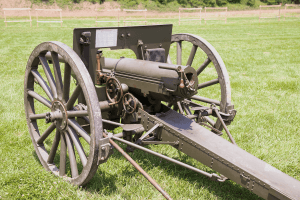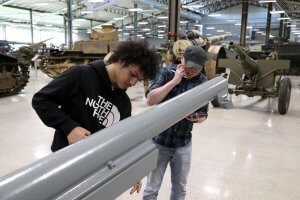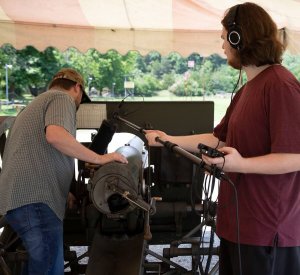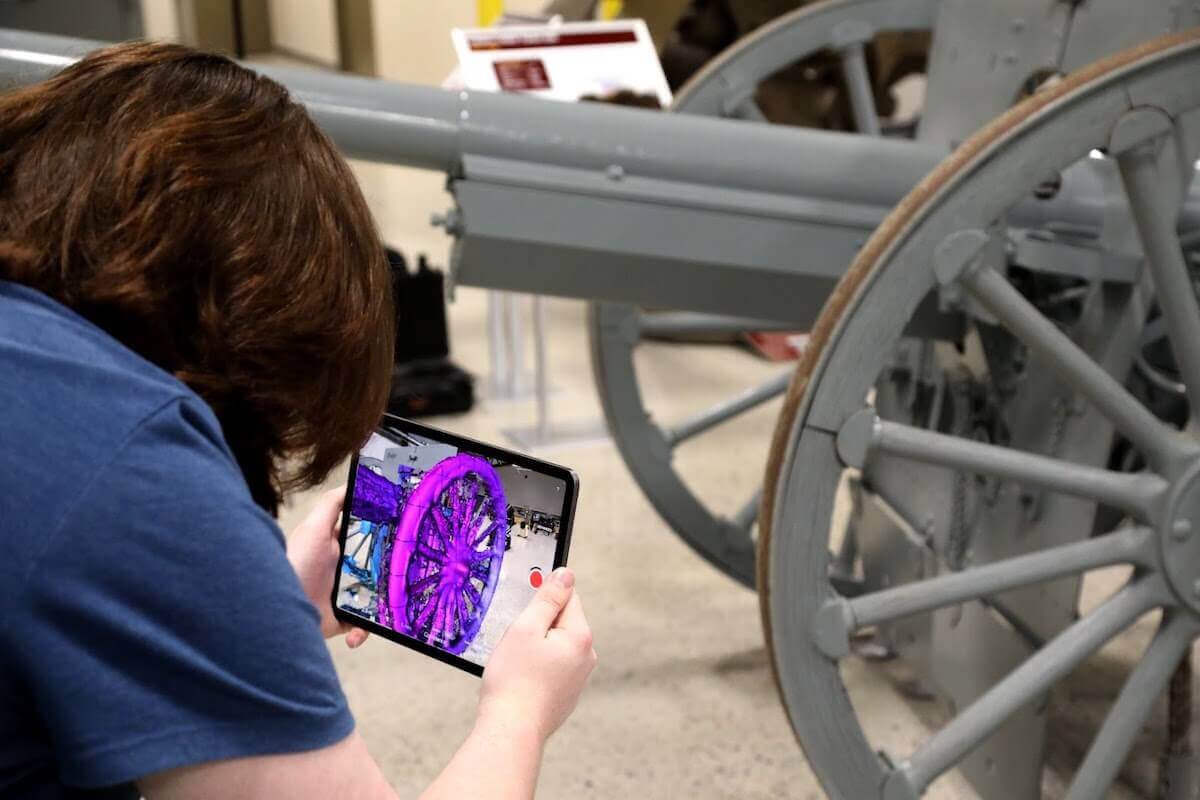A Shenandoah University virtual reality design professor and his team are developing a VR program that would place users in the shoes of a World War I artilleryman.
Nathan Prestopnik, Ph.D., associate professor of virtual and augmented reality, is leading a group of SU colleagues and students that spent the summer gathering the necessary information to virtually construct a French 75 field gun. Named for its 75 mm bore, the horse-drawn cannon was used by the French army – and later, U.S. forces – extensively during WWI and is widely considered to be the first modern artillery cannon.
 The French 75 VR program will allow users to operate the field gun, and Dr. Prestopnik said he’s exploring multi-user interaction that would allow participants to work together in the virtual space, much as a real gun crew would.
The French 75 VR program will allow users to operate the field gun, and Dr. Prestopnik said he’s exploring multi-user interaction that would allow participants to work together in the virtual space, much as a real gun crew would.
To add more depth to the project, Prestopnik intends to base the virtual gun crew members on actual WWI U.S. soldiers, allowing users to adopt the persona of their soldier and learn more about their personal story while performing tasks inside the VR program.
Prestopnik, whose research at SU focuses on interaction design as it relates to the digital humanities, explained that the French 75 research project is meant to “connect our modern perspective” to what was occurring during WWI using a “tangible” virtual environment that people can interact with.
Virtual reality is a really cool medium for bringing things to life that you can no longer experience, or that maybe in some cases you wouldn’t necessarily want to experience through actual reality but you want to gain insight into.”
Nathan Prestopnik, Ph.D., associate professor of virtual and augmented reality

In order to accurately reconstruct a French 75 in virtual form, Prestopnik’s team had to get its hands on the real thing.
Prestopnik, SU Immersive Technology Specialist/Extended Reality (XR) Developer Wes Brown, and students Luke Yager ’25 and Malakhi Basquez ’25 traveled to Fort Lee, Virginia, in April and were granted access to a French 75 housed in the U.S. Army Ordnance Training Support Facility. The team took photos, 360-degree videos and 3D scans of the cannon, which helped the project immensely, Prestopnik said. However, the artillery piece at Fort Lee was missing some key pieces and wasn’t operational.
Fortunately for Prestopnik, he eventually came in contact with Matthew Switlik, a collector from Michigan who owns a fully operational French 75. Switlik agreed to transport the artillery piece to Virginia and, after taking care of all of the necessary paperwork, brought his French 75 – and an artillery caisson – to the North-South Skirmish Association in Winchester in mid-July.

Switlik, who has collected cannons for over 40 years, said most French 75 field guns in the U.S. were converted to salute guns in the early 1940s and that it’s rare to find an operational model with original French 75 parts and carriage. Switlik spent decades restoring his cannon to operational status by acquiring the necessary parts – including the gun tube and recuperator, a key piece of the gun’s revolutionary recoil system – from fellow collectors in the U.S. and overseas. He said his cannon is the only French 75 of its kind, to the best of his knowledge, in the United States.
During Switlik’s visit, Prestopnik, Brown and Yager took more photos, video and 3D scans, as well as audio recordings of the sounds produced by performing various actions such as opening and closing the gun’s breech, turning the elevating crank, and removing artillery shells from the ammunition caisson.
All three also witnessed a full demonstration of the gun in action, and each got to fire the French 75 at the North-South Skirmish Association’s gun range using blank rounds and rounds that fired small projectiles similar to a shotgun shell.
Working with Matt Switlik and his French 75 artillery gun was an amazing experience. During the visit, our team had the opportunity to interact with different types of World War I-era weaponry and we took 3D scans of them to use in future simulations. Helping set up all the cameras and equipment we used for the scans and videos was a great learning experience. Matt even let us shoot the French 75 at the end, which only made me more excited about this project!”
Luke Yager ’25, virtual reality design student
Prestopnik said an important first milestone will be the creation of a basic VR environment that incorporates audio recorded from Switlik’s visit, a step that could be completed by the end of the Fall 2022 semester. Prestopnik and his team also hope to create a high-fidelity model of the French 75 in an interactable VR experience, which will showcase the program’s multi-user interaction, by the end of the 2022-23 academic year.




